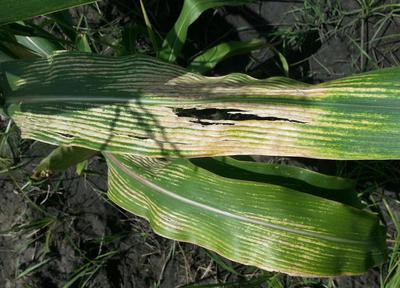Maize Lethal Necrosis Disease
MLND
Virus
In a Nutshell
- Leaves show a yellow-green mottled pattern, often parallel to the veins.
- The leaves begin to dry from the margins and progressing toward the midrib.
- In severe infections, the whole plants withers and dead hearts are visible inside the stems.
- Growth is stunted, the inflorescences are sterile, and the ears are malformed and partially filled.
- The affected plants become the target of opportunistic fungi and nematodes, leading to rots.
Can also be found in
Symptoms
In early infection stages leaves show a yellow-green mottled pattern, often parallel to the veins and starting at the base. As the disease progresses, the leaves begin to dry, usually from the margins toward the midrib. In severe infections, this symptom can gradually extend to the rest of the plant and dead hearts are visible in stems cut open. The growth of infected plants is stunted, the inflorescences are sterile, and the ears are malformed, shortened and partially filled. The affected plants are weakened and can become the target of opportunistic fungi and nematodes, leading to rots of tissues and deterioration of grain quantity and quality.
Recommendations

Organic Control
Sorry, we don't know any biological control measures against this disease.

Chemical Control
Always consider an integrated approach with preventive measures together with biological treatments if available. There is no chemical treatment for virus diseases. Some insecticides can be applied as a seed treatment and as foliar spray to control the population of insects that spread the virus.
What caused it?
All maize plants are susceptible to the disease. However, the symptoms vary considerably depending on the combination of viruses present, the environmental conditions and the vegetative stage of the plant. The disease is actually caused by a combination of two viruses, the maize chlorotic mottle virus and another virus, in most cases the sugarcane mosaic virus. These infection agents are mainly spread in and between fields by vectors such as maize thrips, rootworms, and leaf beetles as well as cereal leaf beetles. The symptoms are worsened by adverse environmental conditions such as drought, poor soil fertility and inadequate agricultural practices.
Preventive Measures
- Plant tolerant varieties if available.
- Use seeds from healthy plants or from certified sources.
- Plant either early or later to avoid the peak populations of the vectors in your area.
- Uproot and burn severely infected plants to stop the disease from spreading.
- Control weeds in and around the field.
- Do not grow maize as monoculture in the same area.
- Rotate crops with legumes, cowpeas, potatoes, cassava and other non-host crops.



